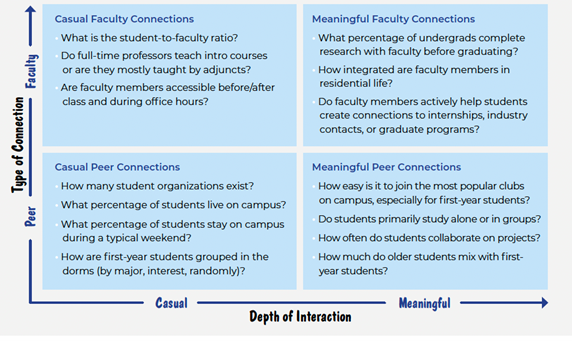Stay up to date with what’s next for higher ed with Jeff’s newsletter
A twice-monthly newsletter with more than 145,000 subscribers, featuring Jeff’s unique blend of storytelling and provocative insights on higher ed.
☀️ Good Morning! Thanks for reading Next. If someone forwarded this to you, get your own copy by signing up for free here.
In today's issue: AI in the job market and as we enter a new academic year; culture as the "operating system" of campuses; and the political divide is really now all about the college degree.
EVENT
One of the inspirations for my new book, Dream School, was Frank Bruni’s Where You Go Is Not Who You’ll Be.
So I’m thrilled that Frank, a New York Times columnist, will be joining me next week in virtual conversation about my book. And you can join us, too, in a conversation organized by one of my favorite groups, the Family Action Network (FAN).
📆 Wednesday, September 3
⏰ 8 p.m. ET/7 p.m. CT
📍 Register for free.
✈️ High school counselors, college admissions officers, IECs: If you’re headed to Columbus next month for the annual NACAC conference, I’ll be there, too, with my new book. I'm part of two sessions and have a booth in the exhibit hall, plus:
🚀 Dream School launches into the world in 12 days.
There’s still time to pre-order the book because when you do, especially now in the days before it hits shelves, the Amazon rankings go up and its algorithms go into overdrive. But it’s not just Amazon.
I encourage you to support your local bookstore, and pre-ordering the book now ensures they have copies on hand for other customers. Also, overall sales before the book comes out tells my publisher people are interested in it and they’ll do more to support it.
Most of all, if you pre-order now, you’ll get access to:
Even if you already ordered, tell your friends about this offer. It’s good for the hardcover, e-book, or audio version from any retailer.
🔮 About that 18-page guide… Dan Porterfield, the CEO of the Aspen Institute and former president at Franklin & Marshall College, called it a "product by itself" on a recent webinar.
If you didn’t see the guide yet, I wanted to offer a preview: One of the exercises in it helps you spot the difference between the connections that colleges brag about on the tour but are often surface-level and the meaningful relationships that really matter in college.
Here’s some evidence you should look for of those meaningful connections laid out in a 2x2 matrix. In the guide, I also provide a blank 2x2 matrix that students can use for each campus they’re considering.

THE LEAD
The worry panic about AI eating entry-level jobs continues with a new report from Stanford researchers that uses ADP payroll data.
The big picture: Employment for younger workers (ages 22–25) in AI-impacted jobs, such as software development and customer support, has fallen by 16% since late 2022.
While colleges love to talk about how they educate students for life, and not just for their first job, so much of higher ed’s public perception is tied to the first job.
And that first job provides new graduates additional training, access to mentors, and the beginnings of a career path that lead to the second job, the third job, and so on.
Bottom line: If the first rung on the career ladder for new college grads is disappearing because of AI, colleges will not only need to rethink how they talk about their post-graduate outcomes to prospective students, but also what they’ll need to add to the undergraduate experience to help students gain the skills and insights in college that they would have gained in their first role after college.

Photo: Gathering in Austin earlier this week with college leaders to discuss AI and the future of higher ed.
AI was the topic of my latest salon dinner, held in Austin earlier this week, with college leaders from around Texas (thank you to Adobe for their support of this gathering). My special guest was Eddie Watson, co-author of Teaching with AI: A Practical Guide to a New Era of Human Learning and vice president for digital innovation at the American Association of Colleges and Universities (AAC&U).
My key takeaways from the conversation:
Ditch blanket AI bands; embrace transparency. Instead of institution-wide policies on AI, institutions are increasingly favoring policies by school, academic major, or even individual classes. Transparency with students is key, requiring discussions at the beginning of the course or before assignments, such as Here are the outcomes we expect with this course. Here’s what we want you to get out of this assignment. Here’s why we don’t want you to use AI for this assignment. Here’s why we do want you to use it.
Double down on foundational skills. Even before AI, one of the biggest complaints from employers was that new college grads lacked the basics: critical thinking, communication, problem-solving. AI might help augment those skills, but it doesn’t replace them (at least not yet). In an era of AI, a college education needs to provide students with more opportunities to struggle with ill-structured real-world problems across disciplines.
Leverage AI for the messy work. AI allows us to more rapidly prototype an idea compared to the normal feedback loops. Instead of writing a paper and waiting days or weeks for feedback, students can now get immediate feedback to iterate on their ideas and produce multiple drafts more quickly. How can colleges embrace how AI is already being used in the real world to develop rapid prototypes?
Begin small with curricular reform. No curriculum can keep up with advancements in AI. So sweeping changes might be impossible, but starting small is crucial. One idea: focus on capstone courses for students graduating in the spring of 2026.
Prepare for AI-driven courses. AI agents can act as students taking courses and completing assignments. They already are. Also, AI can create its own asynchronous courses minus the professor, the students, and the credential (at least for now), but if those elements aren’t important to the student, then it’s likely the free AI-powered course would be preferred.
Two free resources discussed at the dinner:
Campus culture isn’t just a vibe. Think of it as your institution’s “operating system.”
In the third part of a five-part series I’m writing, “Driving Culture Change in Higher Ed,” I argue that colleges can design culture with the same intentionality they bring to budgets or their technology systems.
Why it matters: Too often, leaders treat culture as soft or organic. In reality, it’s malleable, and often the only durable competitive advantage in higher ed’s turbulent market.
How it works: A cultural “master plan” is a blueprint that keeps culture central to strategy rather than sidelined as “soft stuff.” It takes big, fuzzy goals (“be more innovative,” “improve collaboration”) and makes them tangible by:
Examples from the paper:
👉 Read the third paper in the series, “Designing Intentional Change” (with support from Amazon Web Services)
SUPPLEMENTS
Visa Delays and International Students. The latest on the fate of international students in this Inside Higher Ed piece echoes what I recently heard on a trip abroad. Interview slots for visas at American embassies and consulates are booked up, making it nearly impossible for many international students to get to the U.S. for the fall semester. The delays are caused by a pause that was put into place earlier this year, hiring freezes at the State Department, and longer interviews to review an applicant’s social media. We won’t know for a few more weeks who actually shows up. College leaders tell me they’re glad they told many international students to stay for the summer so they could start the fall semester on time. (Inside Higher Ed)
The End of Hispanic-Serving Institutions? “The Trump administration is refusing to defend a lawsuit challenging a federal program that provides $350 million in grant funding to colleges with large populations of Hispanic students, a move that threatens the future of similar programs to help minority students.” (The Washington Post)
The Education Divide and American Politics. “America is in the midst of a vast political realignment…and the biggest indicator of how someone will vote is now based on education...One statistic on how much things have changed: At the start of former President Barack Obama’s first term, Democrats had 60 members in the Senate. Since then, they have lost 18 seats in states where less than 35 percent of the population has a four-year college degree.” (Politico)
Until next time, Cheers — Jeff


A twice-monthly newsletter with more than 145,000 subscribers, featuring Jeff’s unique blend of storytelling and provocative insights on higher ed.
Finding the college that’s right for you
Dream School is a must-have playbook for families coping with a more stressful era of college admission that gives them a roadmap for finding a good college where their teen can thrive, learn, and become the person they’re meant to be.
